
by Les Harrison | Apr 23, 2018
Spring 2018 is barely out of the starting gate. All kinds of plants are sprouting and producing blooms! This week’s last gasp of winter temperatures slowed the progress, but only slightly.
Much like the Easter egg hunts a few weeks ago, a search of the landscape can bring multiple surprises. Two colorful plants, spiderwort and rustweed, which are growing in the region fit into this category.
Tradescantia ohiensis, the scientific name for spiderwort, is a herbaceous native plant. Its most striking feature which makes it easily identifiable is the cluster of bright purplish-blue blooms which are currently on display.

Spiderwort in full flower. Image Credit Les Harrison
To the casual listener, the name spiderwort implies an arachnid with a complexion issue. Far from it, but the terminology is shrouded in agriculture and horticulture history.
The term wort, in its various forms, can be traced back to northern Europe to well over 1,000 years ago. Its meaning related at first to herbs, and then to plants without bark or hard stems.
It should not be confused with wart, a skin eruption relating to a virus. Contact with any part of the spiderwort does not infect a person with warts.
The spider part of the name relates to the flower peddles. In harsh sunlight of the afternoon, the Spiderwort’s peddles are reduced to fine threads similar to a spider’s web.
Spiderworts are often seen along fencerows, in pastures and untended fields, and it forested areas. They bloom from late spring to early summer and usually grow in clumps or bunches of plants.
The plant clumps are easily separated and transplanted. Spiderwort has been used in ornamental horticulture as a showy, low-cost alternative for many years.
They expand their presence in the wild slowly, but persistently. Since there are no herbicides labeled for their control, they are considered a pest species by some hay producers.
Another plant with a colorful name, and which is considered a pest, is the rustweed (Polypremum procumbens). While it does not literally rust, it gets its name from its rust colored foliage in the autumn.
In spring and summer this low growing perennial is a Kelly green fitting for St. Patrick’s Day, and easily blends with Bermudagrass and other turfs as they make their season emergence. Tiny white blooms soon to come will confirm it presence, but this is often overlooked when in landscapes and lawns.
This plant spreads by seed, which are small and heart-shaped. One means of colonizing new areas is by seed lodging in mowing and other equipment, then depositing in new areas when the equipment is relocated.
As with all grasses in the Florida panhandle, rustweed is found only in sunny areas. This little known plant is an area native, but also occurs as far away as South America.
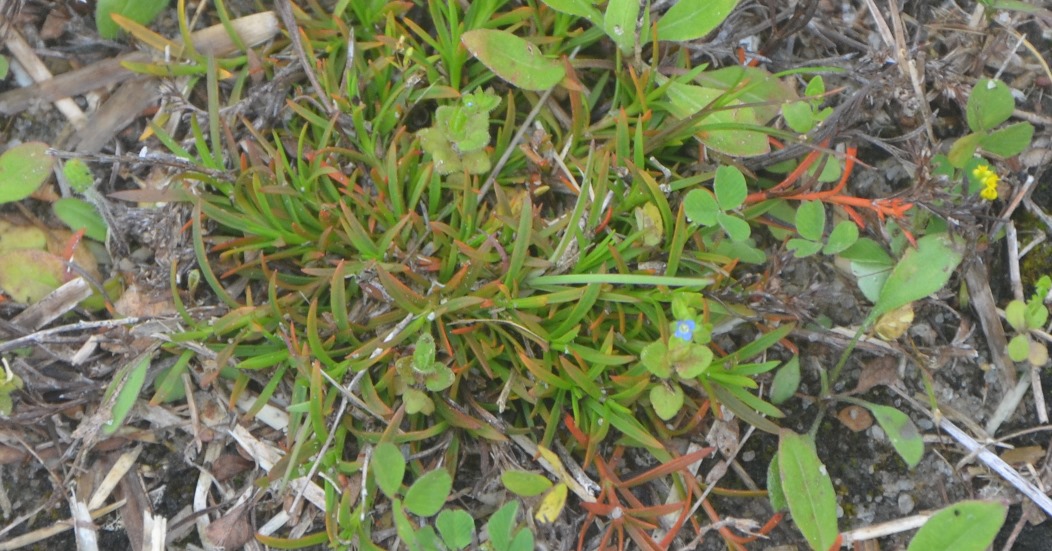
Rustweed, among others, in a Florida lawn. Image Credit Les Harrison
This aggressive native will quickly establish itself and push out other more desirable species. Mowing will not slow its progress.
After the multiple frost and muted earth tones, both spiderwort and rustweed are currently adding variation to the landscape’s hues as the weather warms.
To learn more about weeds in north Florida, contact your local UF/IFAS County Extension Office. Click here for contact information.
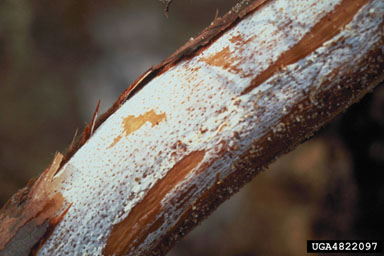
by Matt Lollar | Apr 23, 2018
Recently, an Extension Agent in the Florida Panhandle received a picture of some mushrooms popping up in a client’s garden. These particular mushrooms were in a spot where leftover mushroom compost had been dumped. The compost was previously used to grow oyster mushrooms and the client was hopeful that she had more oyster mushrooms growing in her yard. Unfortunately, the lab results came back stating the mushrooms in question were Armillaria spp.
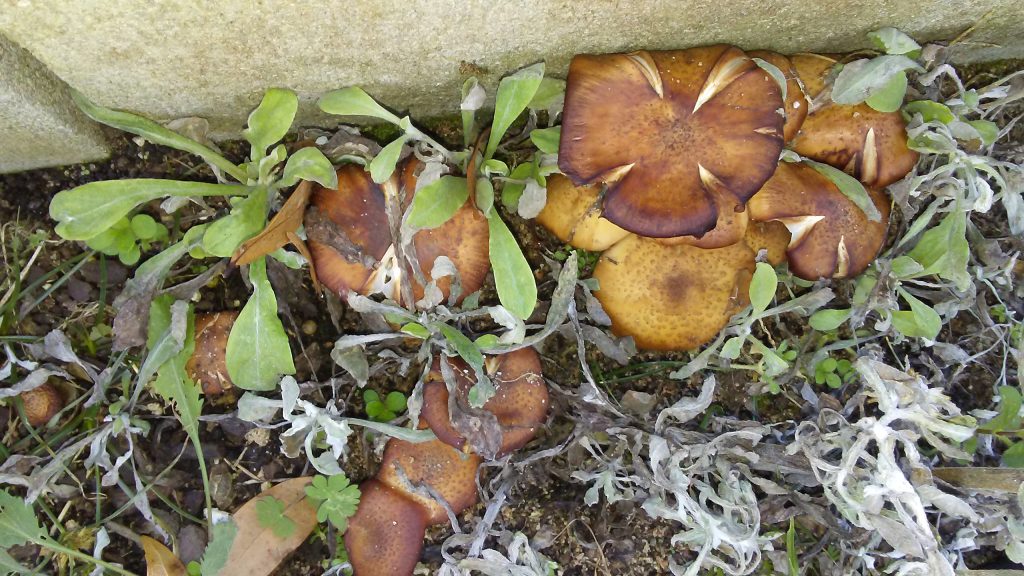
Armillaria spp. in the garden. Photo Credit: University of Florida/IFAS Extension.
Armillaria spp. cause root rot of trees and shrubs throughout the world. The fungus infects the roots and bases of trees, causing them to rot and eventually die. Some species of Armillaria are primary pathogens that attack and kill plants, but most are opportunistic pathogens that are attracted to unhealthy or stressed plants. Fruiting structures of the fungi can be recognized by the clusters of yellow to brown-colored mushrooms that emerge during wet conditions. However, the mushroom caps sometimes never form and the plant material needs to be inspected more thoroughly to find the disease culprit. Infected plants may have wilted branches, branch dieback, and stunted growth and should be removed and replaced with resistant species.

White mycelial fan under the bark of a root infected with Armillaria tabescens. Photo Credit: Ed Barnard
Management – The best method for controlling Armillaria root rot is with proper plant installation and maintenance. Planting plant material at the proper depth will allow the roots to breathe and reduce the opportunity for the roots to rot. Pruning tools should be sanitized between plant material. Proper irrigation and fertilization will also reduce the risk of plant disease and root rot. Lastly, you can choose to plant a diverse landscape with resistant species.
For more information on Armillaria root rot and a comprehensive list of resistant species, please view the EDIS publication: Armillaria Root Rot

by Sheila Dunning | Apr 23, 2018
With cool, foggy mornings you may have noticed the large number of spider webs hanging on low vegetation. Some of them have unusual shapes. One of the most notable is the bowl and doily spider. This spider (Frontinella pyramitela) is a species of sheet web weavers found throughout the United States, including Northwest Florida.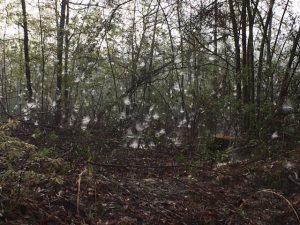
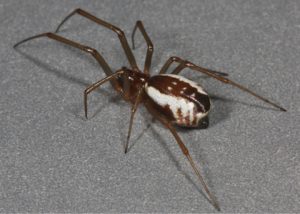 It is a small spider, about 3-4 mm (0.16 in) long, boldly marked with black and white stripes on the abdomen, a brown cephalothorax, and brownish legs. They weave a fairly complex shaped webs only a few inches across, usually well off the ground and stretched between twigs or other objects. Webs consist of an inverted dome-shaped web, or “bowl”, suspended above a horizontal sheet web, or “doily”, hence its common name. The webs are approximately circular when viewed from above, where there is a tangled scaffold “knock down” threads of silk invisible to flying insects. The webs are commonly seen in weedy fields and in shrubs.
It is a small spider, about 3-4 mm (0.16 in) long, boldly marked with black and white stripes on the abdomen, a brown cephalothorax, and brownish legs. They weave a fairly complex shaped webs only a few inches across, usually well off the ground and stretched between twigs or other objects. Webs consist of an inverted dome-shaped web, or “bowl”, suspended above a horizontal sheet web, or “doily”, hence its common name. The webs are approximately circular when viewed from above, where there is a tangled scaffold “knock down” threads of silk invisible to flying insects. The webs are commonly seen in weedy fields and in shrubs.
Small flies, gnats and other small insects crash into the strands of barrier silk and fall down into the non-sticky webbing. The spider hangs from the underside of the “bowl”, and bites through the web, pulling the prey through in order to consume them while resting comfortably on the “doily”. Bowl and doily spiders serve a very important ecological role by controlling human-biting and plant damaging insects.
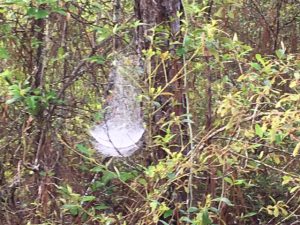 Among web-building spiders, bowl and doily spiders (Frontinella pyramitela) are unusual because both males and females often cohabitate. The males rarely build webs, however, and so depend upon females ‘ snares for food. These cohabiting males capture about 32% of the prey that hit the web despite the female’s efforts to capture the same prey.
Among web-building spiders, bowl and doily spiders (Frontinella pyramitela) are unusual because both males and females often cohabitate. The males rarely build webs, however, and so depend upon females ‘ snares for food. These cohabiting males capture about 32% of the prey that hit the web despite the female’s efforts to capture the same prey.
Mating in this species occurs on the underside of the bowl of the female’s web and is preceded by a complex vibration- and chemical-mediated courtship during the late summer. Eggs are laid in silken sacs in the web or hiding in leaf litter on the ground. Both eggs and adults have been known to overwinter. Like all spiders, bowl and doily spiders develop through simple metamorphosis: spiderlings look like tiny adult spiders (but with lighter coloration), and shed their outer skin in order to grow. Most sheet web weavers live only one year.
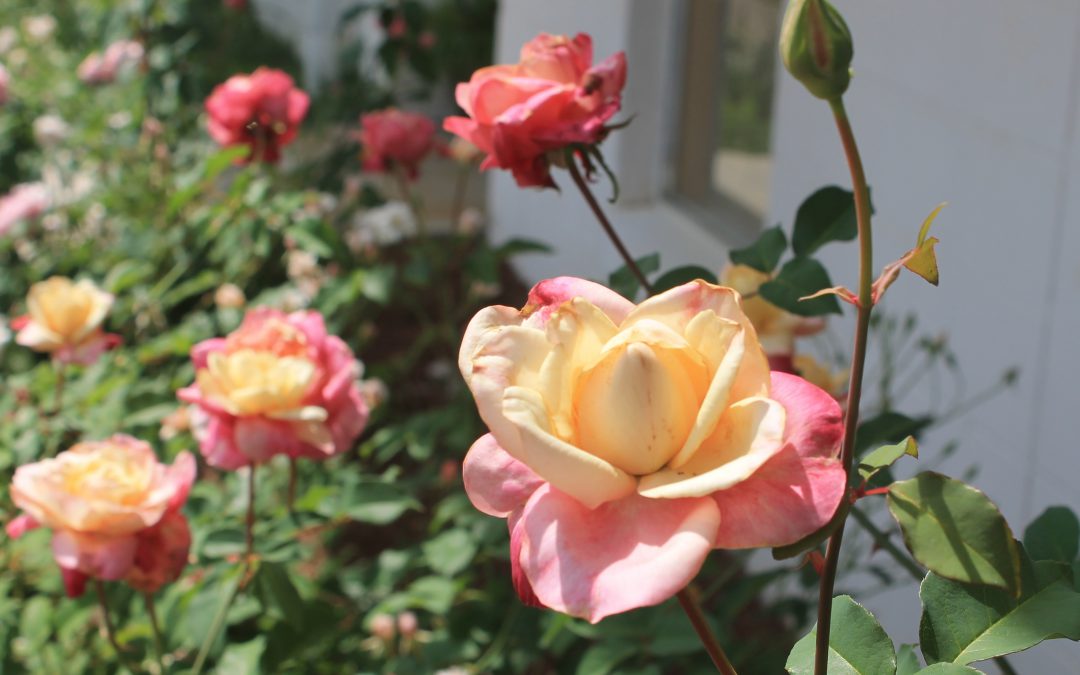
by Matthew Orwat | Apr 17, 2018
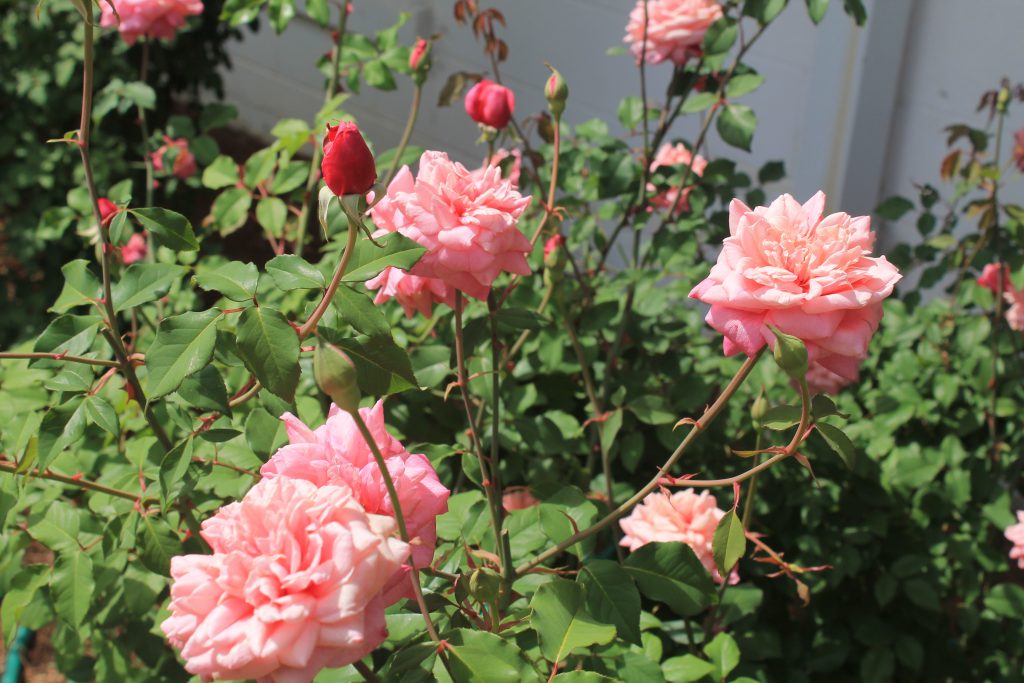
Monsieur Tillier – Tea rose from the late 1800s. A good choice where a large, free-flowering shrub is needed – Image Credit Matthew Orwat
Home Gardeners, when they think of roses, their mind inevitably turns to the ‘Knockout’ rose and its offspring. That’s fine, there’s nothing wrong with ‘Knockout’ roses, it makes a great ornamental landscape plant, and it’s easy to propagate.
With all the ‘Knockout’ mania, since the early 2000s, many garden roses, that are well adapted to the Northwest Florida climate, have been left out of the home garden to a large degree.
Several roses, which were grown in Florida commonly in the last hundred years, and recommended by former University of Florida president H. H. Hume in his book “Gardening in the Lower South,” are still grown here today. To obtain these roses gardeners must look to small nurseries scattered throughout central Florida and Alabama, or order them from larger nurseries in Texas where the “Texas A&M Earthkind Rose Program” has taken off.
Below are a few examples of easy to grow roses, that are just as disease resistant as the ‘Knockout,’ but offer more variety in color and form that home gardeners might enjoy as much as or more than ‘Knockout’. They have been grown successfully throughout southern Texas for over 30 years, and at the Washington County Extension Office for the past seven years without spraying fungicides or insecticides. Several of these cultivars were also involved in a 3-year rose trial at the UF/IFAS North Florida Research and Education Center, in Quincy.
One caveat I have regarding these roses is that disease resistance is lessened when irrigated with overhead irrigation. Even the most disease resistant roses will develop issues if leaves are constantly left wet.
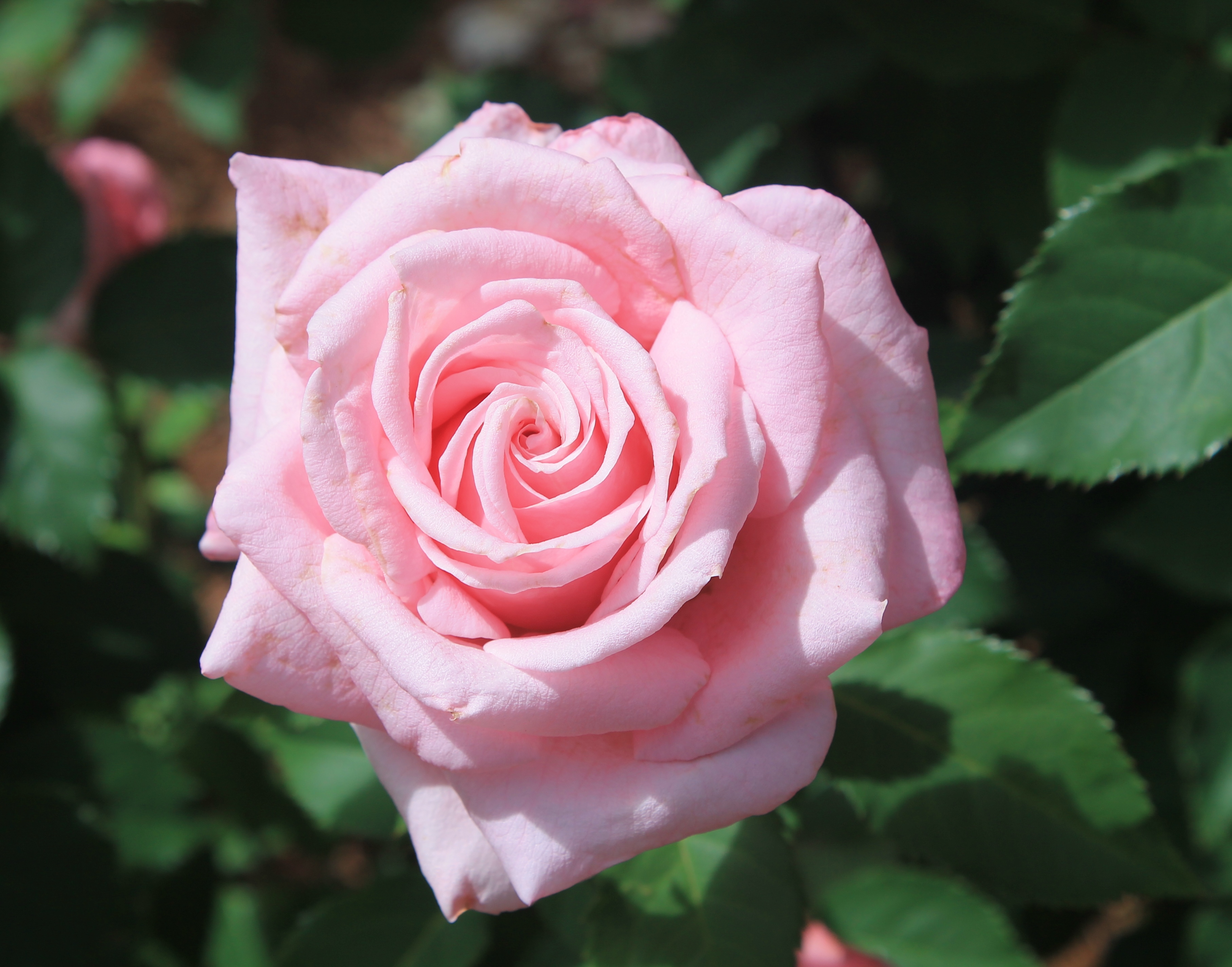
Belinda’s Dream makes a moderately sized shrub and produces large flowers, especially in the spring and fall. Image Credit – Matthew Orwat
‘Belinda’s Dream’
‘Belinda’s Dream‘ was bred by Texas A&M Professor Robert Basye in 1988, as a culmination of years of intense breeding and selection for disease resistant landscape and cut flower roses. It makes a 4-5 foot shrub that grows about 3 feet wide. Apple-green foliage clothe its pleasing shrub form. It’s free flowering but not overly vigorous, so it’s easy to keep in bounds. Disease resistance is high, there’s rarely any blackspot of note, under no-spray conditions, and only slight powdery mildew in a few years when conditions are favorable for fungus development.
In cool spring or fall conditions, the clear pink flowers can top six inches in diameter, and contain over 200 petals, but regular hot conditions during the summer usually reduce flower size to four inches. This rose loves to be part of mass plantings, particularly when planted 3 feet apart in a triangular formation. It has a reputation as being moderately easy to propagate.
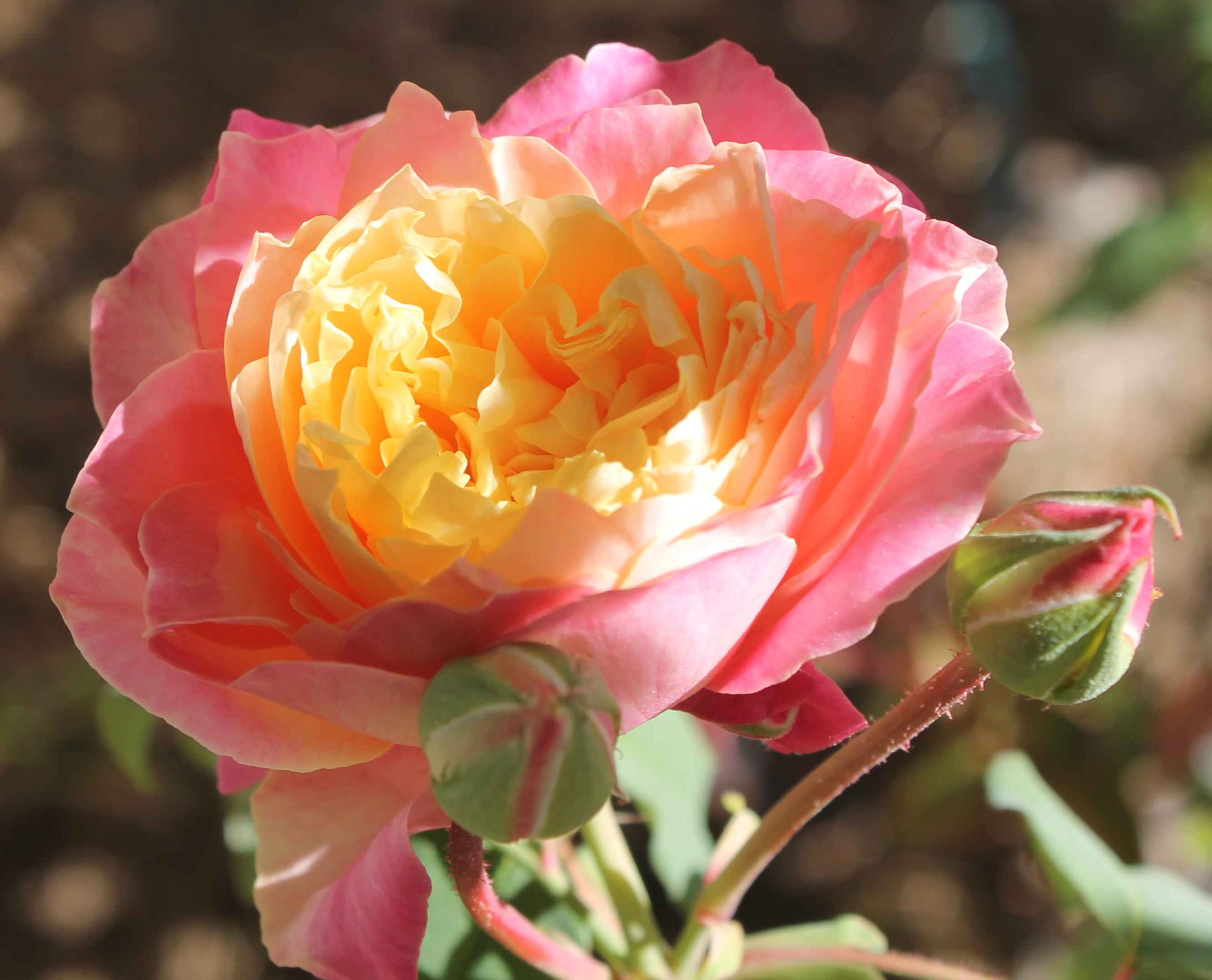
Rosette Delizy is very colorful and disease resistant. A great addition where a spot of color is needed – Image Credit Matthew Orwat
‘Rosette Delizy’
‘Rosette Delizy‘ is a French Tea rose that was introduced to the U.S. nursery trade in the mid-1920s. Since it was bred before the days of modern fungicides, it sports excellent resistance to disease. It shows no powdery mildew, and only the occasional leaf with blackspot under no-spray conditions.
This is strictly a rose for the coastal south, since it does not like cold temperatures, and cannot thrive north of zone 7b without protection.
Color is striking, opening yellow with petal edges changing to pink as the flowers age. Cooler weather brings out deeper russet and maroon tones. It has a light “tea” fragrance. This mannerly shrub gets 4-5 feet tall and 3-4 feet wide. It requires very light pruning, and can actually be killed from heavy-handed gardeners with shears in hand. Minor flaws noted in this rose are that it is somewhat sparsely foliated, and somewhat difficult to propagate.
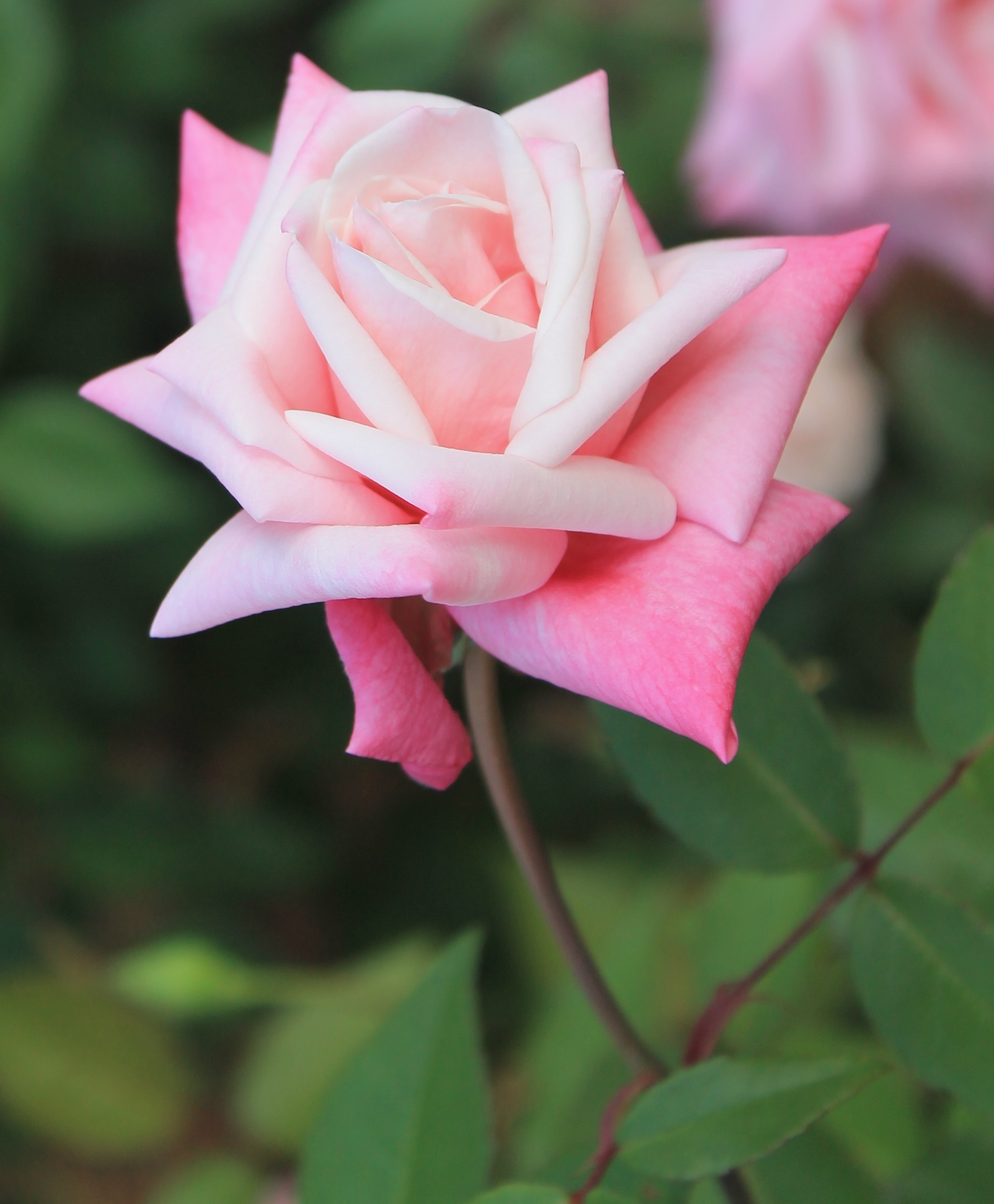
Madame Antoine Mari – The perfect buttonhole rose produces flowers with delicate, soft colors perfect for arranging. This rose is a mannerly grower suitable for smaller landscapes. Image Credit Matthew Orwat
‘Madame Antoine Mari’
‘Madame Antione Mari’, a Tea rose, was introduced in 1900 when the buttonhole rose was all the rage. Massive quantities of perfectly formed delicate buds of pink and ivory quickly open into 3 inch flowers that decorate the bush like butterflies fluttering in the wind. Re-bloom is fast. Additional interest in the landscape is created by the deep red color of new foliage.
This makes a mannerly shrub for the small landscape, easily kept at 3-4 feet tall, and 5-6 feet wide by light pruning. Disease resistance is above average in a no-spray garden, with very low blackspot infection rates, and only occasional powdery mildew. This rose has been found to be easily propagated with the author reaching near 100% success rate.

Mrs. B. R. Cant at the Quincy rose trial in 2013.
‘Mrs. B. R. Cant’
No mention of easy to grow roses is complete without the mention of ‘Mrs. B. R. Cant’. In the trials UF/IFAS horticulturists performed at Quincy and Plant City, this variety was rated the best performer. It has been in continuous cultivation since 1901, and is often found at old home sites and gardens in Washington County.
This makes a large garden rose, easily topping 8 feet in height, and just as wide. Deep pink flowers are borne profusely from March to first frost. Disease resistance is outstanding, and it’s easy to propagate. Plants are densely clothed in medium green leaves. This rose is often grown in hedges as a substitute for a fence. One of the best all-around garden roses for the gulf south.
Nursery Availability
I provide presentations at workshops on these roses multiple times a year, throughout the Florida Panhandle. The recurring question I get is, “Where are these roses available locally?” Hopefully this article will inspire some local gardeners to try these easy to grow roses, and others, since these are just a few of the roses available that do very well in North Florida under no spray conditions. If you are interested in more information, contact, Matthew Orwat at UF/IFAS Extension Washington County.
by Larry Williams | Apr 16, 2018
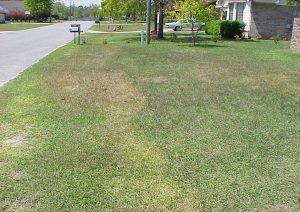
Cold injury to lawn. Photo Credit: Larry Williams
Patience, warmer soil temperature and correct lawn management will solve many spring lawn problems.
Many spring dead spots in lawns are caused by something that happened the previous growing season or winter. For example, a late application of a high-nitrogen fertilizer can decrease winter survival. It’s best to not fertilize our lawns after early September.
An insect or disease problem during fall many times goes unseen as the grass is beginning to go dormant. The following spring, as the lawn begins to green up, evidence of a fall pest is clearly visible by brown dead, grass. The pest may not be present or active during spring.
Poor maintenance practices may be to blame for spring dead spots. Over-watering, shallow watering (watering frequently for short periods), mowing too low, too much fertilizer and herbicide injury can result in poor lawn performance come springtime.
Regardless of cause, problem areas within lawns are slow to recover during spring due to frequent cool night temperatures. Frequent cool nights keep the root zone cool.
Cool soil temperature doesn’t allow rapid root regeneration in spring, which inhibits top growth in your lawn. Cool soil also decreases availability of some needed nutrients. For example, poor availability of iron because of cool soil is a common cause for bright yellow areas within lawns, especially in centipedegrass. Cool soil also decreases availability of phosphorus and potassium, which can result in reddish-purple grass blades, intermingled throughout the yard. As soil temperature increases, availability of nutrients improves and the yellow and purple areas turn green.
Have patience with your lawn and follow good maintenance practices this spring. Provide ½ to 1 inch of water when the grass shows signs of wilt. Fertilize and lime based on the results of a reliable soil test. And, mow at a high setting. Good lawn maintenance info is provided at the YourFloridaLawn website.
Consistently warmer nights will allow the soil temperature to warm, which will improve turf root growth, nutrient availability and lawn recovery. During many years in North Florida, it’s well into the month of May before our lawns begin to recover.
If the lawn has not made a comeback by late spring or early summer, it may be time to consider reworking and replanting the dead areas or maybe consider replacing them with something other than grass, if practical.















